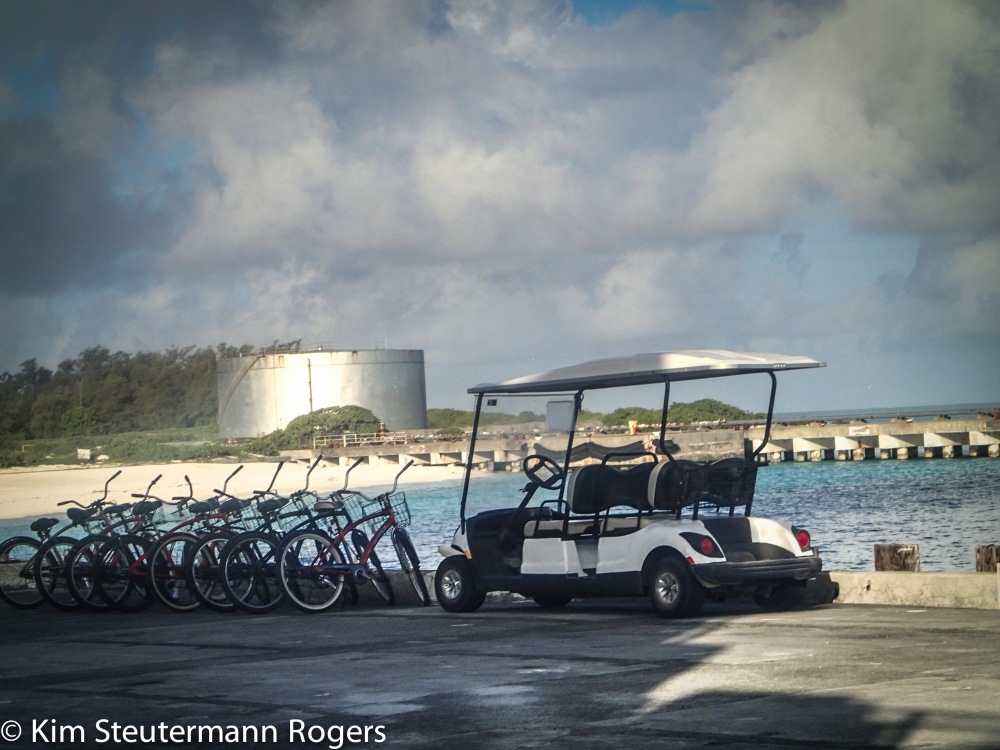
The bikes represent much of what I love about Midway Atoll National Wildlife Refuge, the most well known atoll in the Northwestern Hawaiian Island chain, thanks to a battle fought in these waters during World War II.
The biggest of the islands, Sand, is so small all you need is an old beach cruiser to get around. Slow-moving bikes make it harder to hit birds, too. Because there are birds. During the albatross and petrel nesting season, we’re talking millions of birds, flying at all times of day and night. It’s very Hitchcockian. In September, there are the usual suspects, noddies, boobies, and shearwater. But no albatrosses.
I visited Midway seven years ago to survey albatross nest sites with U.S. Fish and Wildlife Service. Mostly, I just wanted to go on a great adventure, but by the time I departed, I was a devotee. Of albatross and the Northwestern Hawaiian Islands themselves.
The albatross weren’t here during this visit. They won’t return to breed for another month or so. It was weird not seeing—and hearing—dancing albatross occupying every square yard of the island. The giant albatross statue was gone, too. Removed for repair after years of decay and a few too many storms.
But we had monk seal work to do: flipper tagging as many weaned pups as possible.
All but two of this year’s eleven pups born at Midway needed tagging. The tags are much like those used on cattle, but instead of ears, they are placed on each of the seal’s hind flippers. The tag’s color indicates where it was born. The first letter provides the year, and the number identifies the individual seal. These flipper tags are crucial in learning many things about monk seal biology, including life history, habitat usage, and total population.
A few of us were searching for weaners on the west side of Sand Island when our radio crackled to life. It was Chief Scientist Jessie.
I’d already noticed how even the crew aboard the ship had gotten involved in the effort of monk seal conservation. One afternoon while transporting a candidate seal for Ke Kai Ola from the beach to the ship, Coxswain Mills whispered, “Is this too fast?” Another night, Chief Bosun Chris happened to walk by while I was on seal watch. After a day of hauling gear on and off the ship, the crane was creaking something fierce. “Is that too loud?” he whispered to me and thumbed toward the seals on the aft deck. “I don’t know,” I said, “But it’s driving me batty.” And he tightened things, so all I could hear was the noisy Neva and her deep bwah that sometimes goes BWAAAAAAH.
This time, at Midway, Ensign Blair got involved. During his watch, Blair reported a seal with a black ring around its neck in the water near the ship.
Seal team members Sarah and Hope deployed, but the seal swam off before they could help it.
On our survey, my team saw ten juveniles and adults but no weaners to tag and no entangled seal, either.
This would have been the perfect day to write about marine debris. But since I already wrote about the perils of marine debris when we were at Lisianski, here’s what I’ll add: In addition to surveying and identifying individual monk seals, tagging weaners, translocating juveniles from low-to high-survival areas, and collecting underweight females for rehabilitation, monk seal biologists in the field actively remove potentially hazardous marine debris and disentangle monk seals. There’s probably not much more rewarding experience than rescuing a monk seal from imminent death by cutting it away from a ball of derelict fishing net floating in the sea.
Back at French Frigate Shoals, the military built up Tern Island to create a runway for planes. Now, since the military’s departure, the fabricated island is eroding into the sea, exposing its infrastructure of metal and wire at the ocean’s edge. In other places, the ocean is undercutting concrete. The field team there makes morning patrols around the disintegrating island to free seabirds, turtles, and monk seals from entanglements and potential entanglements. Of course, I cannot help but wonder who will look out for the wildlife when the team leaves for the season in a few days time.
Unfortunately, we didn’t find the monk seal with the ring around its neck before our ship departed Midway that evening for Kure Atoll, some sixty miles north and our last stop in the Northwestern Hawaiian Islands. But I didn’t stop thinking about it.
Biologists sometimes have to witness disturbing things in the field, like sharks attacking monk seal pups. That, as they say, is an act of nature, but it’s still no easy thing. The situations that really get to me are those that are human-created, like marine debris, because they feel so preventable.
We spent a day at Kure packing up the season’s field camp and loading it on the Oscar Elton Sette. By the next morning, we were pulling back into Midway and, again, looking for weaners to tag.
Under clear skies, Coxswain Mills delivered a team of us to Eastern Island. It was another of those moments when I said out loud, “This is my favorite time of day.” We zipped along flat water so turquoise you could paint a knock-off of Monet’s famous Water Lillies with it.
Part of the work of a field biologist is waiting. For two hours, we sat on the beach that circles Eastern Island watching several young seals in the water. Then, they hauled out across a tricky channel on a neighbor island, Spit, no doubt named for its size. We radioed to Mills, and he collected us. He’d put our wait to good use, catching a yellowtail tuna that would later be served up sashimi style for dinner.
As Mills pulled the SE4 onto shore, I got a closer look at the hauled out seal. It had a black ring around its neck. It looked like the seal was wearing a neck brace. “It’s entangled,” I said.
That’s when our crack team of biologists went into action. Ben and Carrie grabbed a stretcher net that would be used to catch the seal. Within minutes, Ben and Carrie had the seal in the net, and Ben was tugging the ring off the seal’s neck. It turned out to be a six-inch long piece of plastic tubing, and the seal turned out to be a weaner. So, while it was restrained, another team member, Lauri, tagged it. In the Hawaiian Monk Seal Research Program, the disentangled weaner is now known as PG20.

When we returned to the boat, we showed the plastic tubing to Mills. “WTH,” Mills exclaimed, although the “H” may have been an “F,” and he may have said the actual words, not just the acronym.
Meanwhile, we heard over the radio a report of another entangled seal back on Sand Island. This was an adult female with a line as fat as my index finger around her mid-section. Thankfully, another team was able to catch her, cut the line, and because it hadn’t embedded into her body yet, it easily fell off. Had it been embedded, we would have been facing a medical procedure. And had she never been found, at all, she may have faced serious complications when she got pregnant—and fat.
Not all entanglements happen just when a ship of scientists show up. And not all are as easily removed. But we departed Midway that day at sunset knowing we had helped two monk seals survive another day. I saw a giant green sea turtle in the lagoon as we motored out, two large trevally chasing baitfish, and a manta ray at the mouth of the harbor, but it was one other image I saw just as we shoved off the pier that sticks with me: That of the Executive Officer of the Oscar Elton Sette wielding a 30-foot-long pole with a hook on the end to fish marine debris out of the water. Because it takes an entire ship, scientists and crew alike, to save a species.

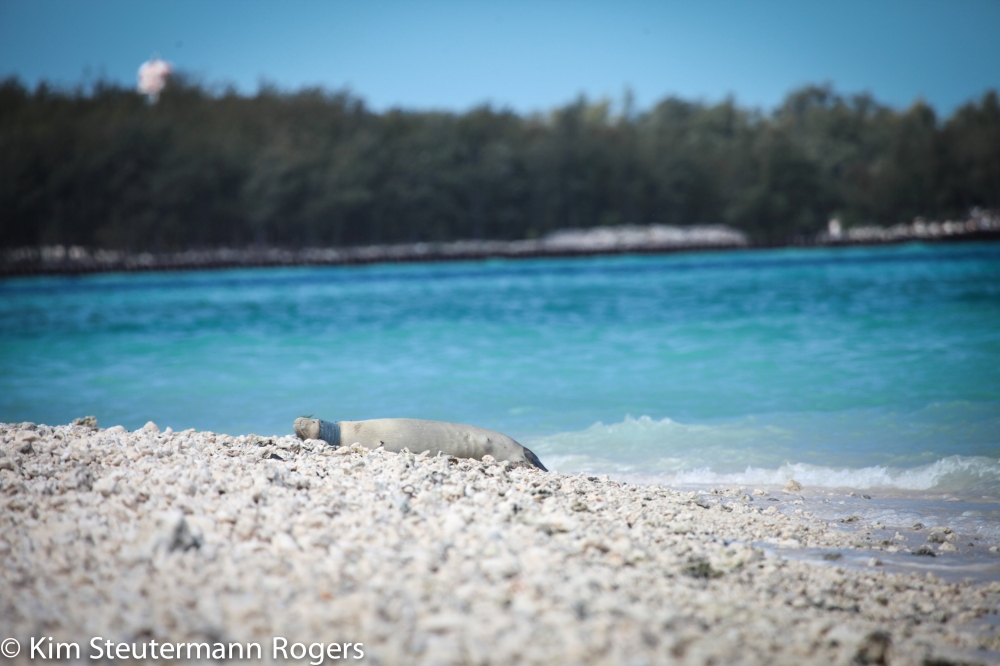
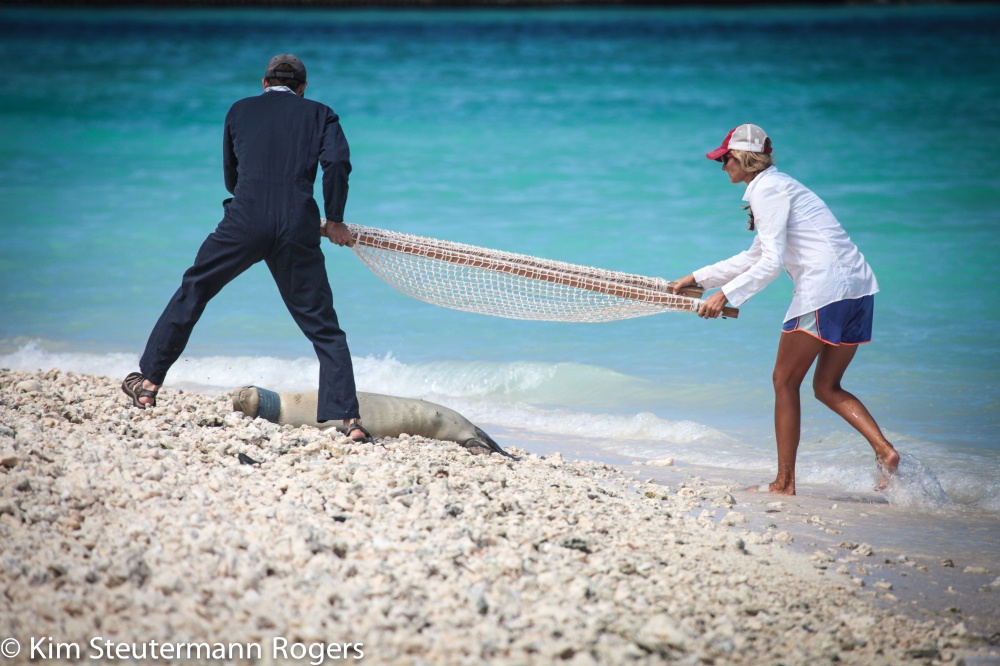

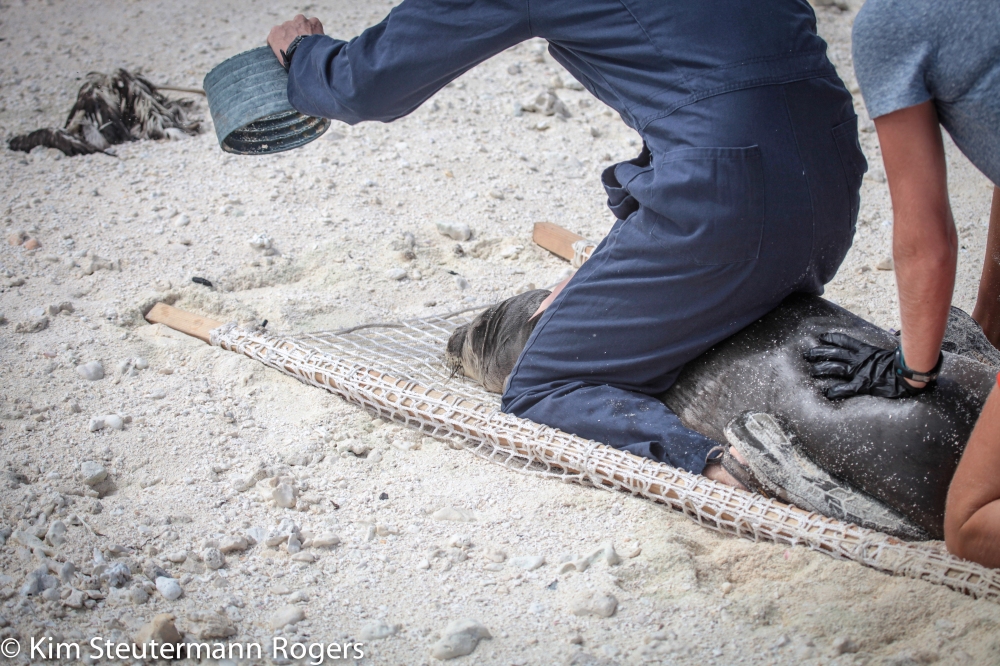
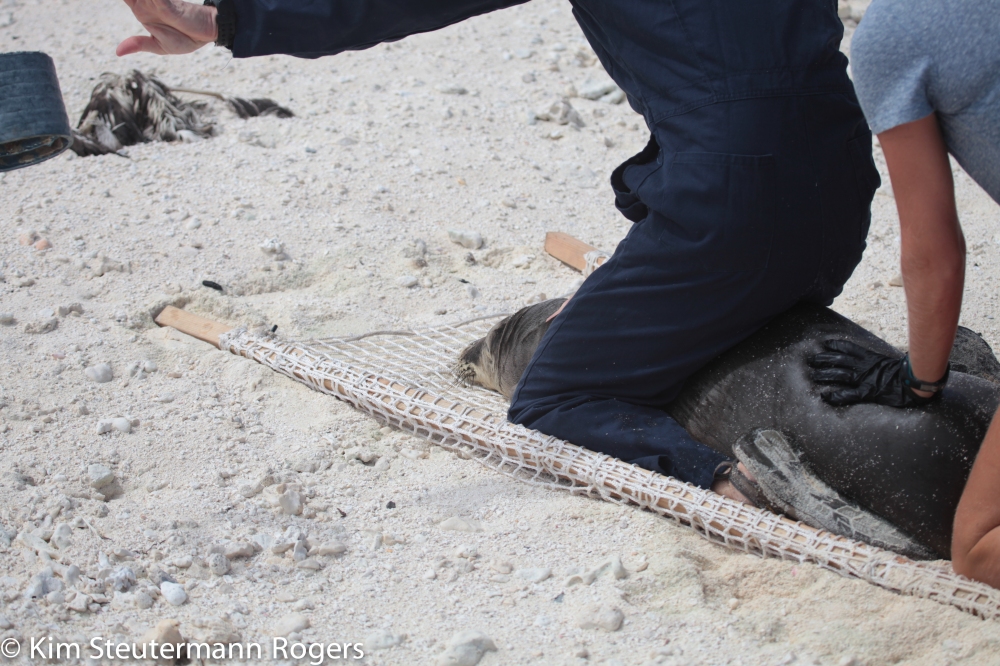
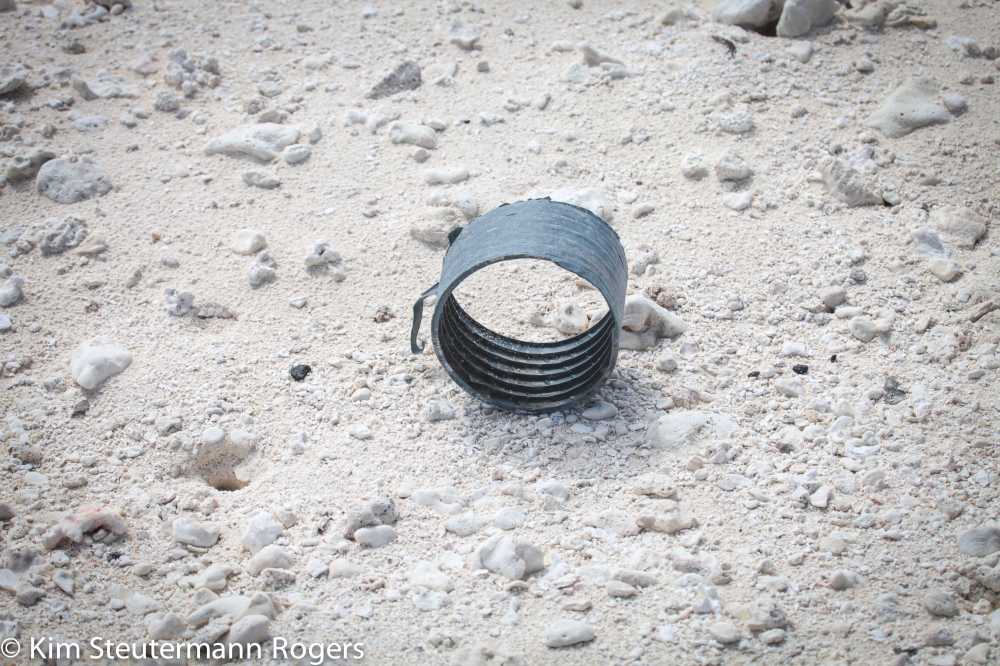
Very interesting. You will have so much to tell us.
LikeLike
And I have to pick and choose! There are many stories to tell;-)
LikeLike
continuing to REALLY love reading these adventures. You’re doing great work, Kim!!!
LikeLike
Thanks, Sue. I feel like I’m just reporting the great work being done in our natural world;-)
LikeLike
Kim, You write beautifully! I do enjoy your posts. How is Ama Ama doing?
Sent from my iPhone
>
LikeLike
Great question. She and Puka stowed aboard a special flight (or two) to Ke Kai Ola on Big Island a couple days go. Report is she’s eating fish!
LikeLike
Mahalo nui loa for caring so much. 🙂
LikeLike
My pleasure. We seem to have a ship full of caring people;-)
LikeLike
That’s a *fantastic* picture that you’ve entitled, “Disentangling Hawaiian Monk Seal at Midway”. I can’t believe the size of that black tube; good goin’!
LikeLike
Thanks, Barb. Too bad I chopped off the seal team’s heads! I’ll post more photos of the entire event when I get back to land and decent wi-fi;-)
LikeLike
I enjoy reading your stories, Kim. Mahalo for sharing.
LikeLike
My pleasure. And mahalo to you for reading!
LikeLike
Once again Kim, you nailed the essence of the entire project. So wonderful that you have contributed so much along this amazing journey.
LikeLike
Thanks. The journey is winding down, and I find myself with mixed emotions about that!
LikeLike
Yes, nature can be harsh, but there is just no way to forgive human carelessness.
LikeLike
Agreed.
LikeLike
Wonderful to share your work and adventures vicariously. Mahalo nui loa!
LikeLike
Thank you for reading Lynette!
LikeLike